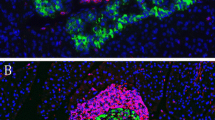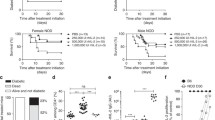Abstract
INSULIN-dependent diabetes mellitus is characterized by the infiltration of lymphocytes into the islets of Langerhans of the pancreas (insulitis) followed by destruction of insulin-secreting β-cells leading to overt diabetes1–5. The best model for the disease is the non-obese diabetic (NOD) mouse6,7. Two unusual features of the class II major histocompatibility complex (MHC)8,9 of the NOD mouse are the absence of I-E9 and the presence of unique I-A molecules (I-ANOD)10, in which aspartic acid at position 57 of the β-chain is replaced by serine. This feature is also found in the HLA-DQ chain of many Caucasians with insulin-dependent diabetes mellitus11–13. We have previously reported that the expression of I-E prevents the development of insulitis in NOD mouse14,15. Here we report that the expression of I-Ak (AαkAβk) in transgenic NOD mice can also prevent insulitis, and that this protection is seen not only when the I-A β-chain has aspartic acid as residue 57, but also when this residue is serine. These results show that the single amino-acid substitution at position 57 of the I-A β-chain from aspartic acid to serine is not sufficient for the development of the disease.
Similar content being viewed by others
References
Makino, S. et al. Expl. Anim. 29, 1–13 (1980).
Tochino, Y. In Insulitis and Type I Diabetes-Lessons from the NOD Mouse (eds Tarui, S., Tochino, Y. & Nonaka, K.) 3–10 (Academic, New York, 1986).
Makino, S., Harada, M., Kishimoto, Y. & Hayashi, Y. Expl Anim. 35, 495–498 (1986).
Harada, M. & Makino, S. Expl Anim. 35, 501–504 (1986).
Wicker, L. S., Miller, B. J. & Mullen, Y. Diabetes 35, 855–860 (1986).
Rossini, A. A., Mordes, J. P. & Like, A. A. A. Rev. Immun. 3, 289–320 (1985).
Bottazzo, G. F. et al. New Engl. J. Med. 313, 353–360 (1985).
Makino, S., Muraoka, Y., Kishimoto, Y. & Hayashi, Y. Expl. Anim. 34, 425–432 (1985).
Hattori, M. et al. Science 231, 733–735 (1986).
Acha-Orbea, H. & McDevitt, H. O. Proc. natn. Acad. Sci. U.S.A. 84, 2435–2439 (1987).
Todd, J. A., Bell, J. I. & McDevitt, H. O. Nature 329, 599–604 (1987).
Todd, J. A. et al. Science 240, 1003–1008 (1988).
Morel, P. A., Dorman, J. S., Todd, J. A., McDevitt, H. O. & Trucco, M. Proc. natn. Acad. Sci. U.S.A. 85, 8111–8115 (1988).
Nishimoto, H., Kikutani, H., Yamamura, K. & Kishimoto, T. Nature 328, 432–434 (1987).
Uehira, M. et al. Int. Immun. 1, 209–213 (1989).
Watanabe, M., Shinohara, N., Ochi, A. & Hozumi, N. Immunol. Lett. 13, 237–244 (1986).
Malissen, B., Steinmetz, M., Mcmillian, M., Pierres, M. & Hood, L. Nature 305, 440–443 (1983).
Shortle, D., Koshland, D., Weinstock, G. M. & Botstein, D. Proc. natn. Acad. Sci. U.S.A. 77, 5375–5379 (1980).
Braunstein, N. S. & Germain, R. N. Proc. natn. Acad. Sci. U.S.A. 84, 2921–2925 (1987).
Matis, L. A., Sorger, S. B., McElligott, D. L., Fink, P. J. & Hedrick, S. M. Cell 51, 59–69 (1987).
Malissen, M. et al. Cell 55, 49–59 (1988).
Pia-Eva, R., Sherwin, S. R., Kanagawa, O. & Janeway, A. C. Jr Nature 341, 326–328 (1989).
Oldstone, M. B. A. Science 239, 500–502 (1988).
Brown, J. H. et al. Nature 332, 845–850 (1988).
Todd, J. A. et al. Nature 338, 587–589 (1989).
Author information
Authors and Affiliations
Rights and permissions
About this article
Cite this article
Miyazaki, T., Uno, M., Uehira, M. et al. Direct evidence for the contribution of the unique I-ANOD to the development of insulitis in non-obese diabetic mice. Nature 345, 722–724 (1990). https://doi.org/10.1038/345722a0
Received:
Accepted:
Issue Date:
DOI: https://doi.org/10.1038/345722a0
- Springer Nature Limited
This article is cited by
-
The MHC-II peptidome of pancreatic islets identifies key features of autoimmune peptides
Nature Immunology (2020)
-
An overlooked connection: serotonergic mediation of estrogen-related physiology and pathology
BMC Women's Health (2005)





